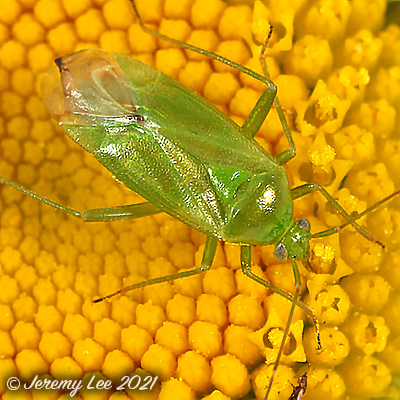
 |
|
Scientific Classifications explained » Amphibians » Ants » Aphids » Bees » Beetles » Birds » Bugs » Butterflies » Caterpillars » Damselflies » Dragonflies » Earwigs » Flies » Frog/Leafhoppers » Fungi » Galls » Grasshoppers » Harvestmen » Hoverflies » Lacewings » Ladybirds » Leaf Mines » Lichens » Mammals » Millipedes » Mosses » Moths » Sawflies » Slugs » Snails » Spiders » Trees » Wasps » Wild Flowers » Woodlice |
UK Nature > Bugs > Lygocoris pabulinus

Scientific Name: Lygocoris pabulinus Common Name: Common Green Capsid Lygocoris species can be distinguished from similar green bugs by the very fine and inconspicuous pale brown tibial spines and at high magnification, the break in the keel between the eyes. The pronotum is rather straight-sided. In Lygocoris pabulinus the pronotum is smooth and the whole upper surface is usually uniformly green. A very common bug throughout the UK, found on a range of woody and herbaceous plants, particularly nettles. They hide under fallen leaves in winter, especially under the hedge, which can be a perfect place for them to lay their eggs. They feed on leaves by leaving small brown holes in the foliage. After the damage is done, they depart, leaving the flowers to open in a lop-sided manner. They can damage fruits as well, by leaving bumps on them. When they drink the sap, they inject their poisonous salivary juices, which can cause buds, leaves and fruit distortions. |
|

https://www.uknature.co.uk is a website dedicated to showing the immense diversity of UK nature and wildlife. Our vast range of habitats, from lowland arable to snow covered mountains, from storm-ravaged coastlines to peaceful inland freshwater lakes and rivers, from dry, sandy heaths to deciduous and coniferous forests, all these habitats contribute to the abundance of UK nature. We have wild birds in huge numbers either residing or visiting our shores (597 recorded species as at July 2013) and we must also not forget the humble back garden with its grass lawns, flower beds filled with nectar rich flowers, shrubs and trees, all designed to attract huge numbers of insects such as bees, moths, butterflies and hoverflies; and finally the small ponds which provide safe havens for frogs, toads, newts and even slow worms and grass snakes. www.uknature.co.uk is the showcase for my personal passion, photographing uknature in all its glory. I sincerely hope you all enjoy the fruits of my labours. This site and all images contained therein is © Jeremy Lee 2004 - 2021. All Rights Reserved. Site design by Jeremy Lee. Site development & IT Support by Stuart Lee. |